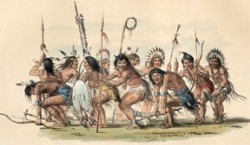By: Daniel Nardini
 It seems these days that a number of things the federal government is doing is taking good and sound concepts too far. In this case, I am referring to a new regulation put out by the U.S. Department of the Interior stating that the remains of people who were discovered on Native American tribes’ land should be “returned.” This regulation also makes it clear that even if the remains were not those of the ancestors of the tribe that inhabits the lands now those remains should still be given to the tribe that makes a request for them. Now I agree with the policy that the remains of those ancestors who can be identified should be returned to the tribes they were taken from. In the 19th and early 20th centuries, those remains that were indeed the ancestors of the present tribes inhabiting the areas they are in now were clearly taken from the lands without the consultation of those tribes. It would be like someone taking the remains of my grandfather and grandmother and using them for “scientific purposes.” In many cases the bones of clearly identifiable Native American ancestors were simply dug up and taken as “war trophies.” This happened a lot during the wars against the western Native American tribes.
It seems these days that a number of things the federal government is doing is taking good and sound concepts too far. In this case, I am referring to a new regulation put out by the U.S. Department of the Interior stating that the remains of people who were discovered on Native American tribes’ land should be “returned.” This regulation also makes it clear that even if the remains were not those of the ancestors of the tribe that inhabits the lands now those remains should still be given to the tribe that makes a request for them. Now I agree with the policy that the remains of those ancestors who can be identified should be returned to the tribes they were taken from. In the 19th and early 20th centuries, those remains that were indeed the ancestors of the present tribes inhabiting the areas they are in now were clearly taken from the lands without the consultation of those tribes. It would be like someone taking the remains of my grandfather and grandmother and using them for “scientific purposes.” In many cases the bones of clearly identifiable Native American ancestors were simply dug up and taken as “war trophies.” This happened a lot during the wars against the western Native American tribes.
But now I am deeply troubled by this new regulation. What if the remains are not identifiable? I shall give a case in point. The remains of a man and a woman who were buried 10,000 years ago were discovered in 1976 in northern California. This discovery at the time heralded an important study that proved that the first peoples of the Americas came much earlier than was imagined. Now a Native American people called the Kumayeey (a tribe in northern California) want these “ancestor bones” back. This argument is highly questionable. Yes, these remains were indeed discovered on Kumayeey land. However, the claim that these remains are those of the Kumayeey is highly questionable in the least. According to Kumayeey tradition their tribe cremated their remains. Considering how old these remains are it is also highly doubtful that they were ever Kumayeey to begin with. Like people everywhere, I seriously doubt that the Kumayeey were there 10,000 years ago. Just as wars and drought and migration pushed so many peoples in Europe, Asia and Africa from one place to the next, so then the same was true in the Americas.
This idea of remains being on someone’s property as being “their ancestors” is highly dubious. It would be like someone discovering a 10,000 year old skeleton in my back yard. Yes, it was on my land (I probably would like compensation for a big hole in my yard), but for me to turn around and say it is “my ancestor” is ridiculous. Every tribe buries their people a certain way and with certain objects and in certain places that makes the graves identifiable. And where this is true we can safely say who are the ancestors of the Kumayeey and the Navajo and the Cherokee. And yes, when we dig up such graves that are not only on their lands but also identifiable can one consider it grave desecration and grave robbing. But when those remains were buried long before the present native peoples were ever there and are not identifiable? This new regulation is wrong and unacceptable. It is unacceptable because it can and will stifle archeological and scientific research at leading universities and research foundations. I do not blame the Native Americans for this new regulation. I do blame the federal government for it because this new regulation has not taken into consideration all sides to the argument. But then, government bureaucrats rarely if ever think these things through.
 Senator Dick Durbin Not Seeking Re-Election April 24, 2025
Senator Dick Durbin Not Seeking Re-Election April 24, 2025








Burying Them Bones
By: Daniel Nardini
But now I am deeply troubled by this new regulation. What if the remains are not identifiable? I shall give a case in point. The remains of a man and a woman who were buried 10,000 years ago were discovered in 1976 in northern California. This discovery at the time heralded an important study that proved that the first peoples of the Americas came much earlier than was imagined. Now a Native American people called the Kumayeey (a tribe in northern California) want these “ancestor bones” back. This argument is highly questionable. Yes, these remains were indeed discovered on Kumayeey land. However, the claim that these remains are those of the Kumayeey is highly questionable in the least. According to Kumayeey tradition their tribe cremated their remains. Considering how old these remains are it is also highly doubtful that they were ever Kumayeey to begin with. Like people everywhere, I seriously doubt that the Kumayeey were there 10,000 years ago. Just as wars and drought and migration pushed so many peoples in Europe, Asia and Africa from one place to the next, so then the same was true in the Americas.
This idea of remains being on someone’s property as being “their ancestors” is highly dubious. It would be like someone discovering a 10,000 year old skeleton in my back yard. Yes, it was on my land (I probably would like compensation for a big hole in my yard), but for me to turn around and say it is “my ancestor” is ridiculous. Every tribe buries their people a certain way and with certain objects and in certain places that makes the graves identifiable. And where this is true we can safely say who are the ancestors of the Kumayeey and the Navajo and the Cherokee. And yes, when we dig up such graves that are not only on their lands but also identifiable can one consider it grave desecration and grave robbing. But when those remains were buried long before the present native peoples were ever there and are not identifiable? This new regulation is wrong and unacceptable. It is unacceptable because it can and will stifle archeological and scientific research at leading universities and research foundations. I do not blame the Native Americans for this new regulation. I do blame the federal government for it because this new regulation has not taken into consideration all sides to the argument. But then, government bureaucrats rarely if ever think these things through.